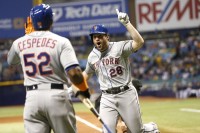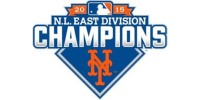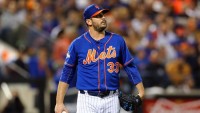Neil Walker
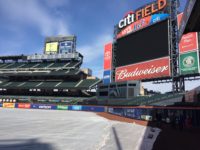
I have a bone to pick with Sandy Alderson. No, it’s not the offense that isn’t hitting. They should hit eventually. Well, we at least hope they will. No, it’s when Alderson dubbed Mets fans “Panic City.”
Let’s remember the context of that gem. The Mets were one game over .500, lost six of their last 10, and were 3.5 games behind the Nationals. They had allowed 14 more runs than they had scored. The Mets had scored the third fewest runs in baseball. The Mets had gone from seven games over .500 with a 4.5 game lead in the division (5.0 games over the Nationals) to falling in the standings. The Nationals were hot, and they were getting better. The Mets were seemingly falling apart while their General Manager was mocking the fans.
Funny thing is the Mets got worse offensively after that. It got to the point where fans were EXPECTING Clayton Kershaw to pitch a perfect game. Not too long after that, the Mets got healthy, made some trades, ran into a cushy August schedule, and they took off. Panic City was forgotten.
Until now.
The Mets are grossly underperforming now. In five of the Mets six games, they’ve scored three runs or less. Terry Collins is batting low OBP guys in front of high OBP guys, and he’s stacking lefties (yes, with Neil Walker‘s L/R splits, he’s effectively a lefty). Mets fans are annoyed as well they should be. But no, that’s not how it’s characterized. Because of Alserson’s comments, we’re “panicking”:
Collins on #PanicCity fretting #Mets' 2-4 start: "It's drama here. It's not drama in Milwaukee. It's not drama in Houston. It's drama here."
— Anthony DiComo (@AnthonyDiComo) April 12, 2016
can't believe the panic i'm hearing out of ny/nj/conn over 2-5. mets will be fine.
— Jon Heyman (@JonHeyman) April 13, 2016
Panic City, assemble!
— Matt Ehalt (@MattEhalt) April 10, 2016
Everybody’s a comedian.
Look, no matter what happens from here on out whenever the Mets have a tough stretch this fan base is going to be mocked for panicking. Honestly, I do not know one Mets fan panicking. Not one. I know if people raising legitimate concerns about a lineup that strikes out a lot and doesn’t have high OBP. But that’s not panic, that’s reality.
I haven’t heard one person declare the season over, demand a trade, or call for Collins to be fired. There’s no panic. There’s just really justifiable frustration over a team that’s not hitting, losing to bad teams, and wasting some good pitching performances. No, Mets fans are colored as being unreasonable and overly reactionary.
We will never see the article about how right the Mets fans were in 2015. We will not see how that the fans were 100% right in their complaints. We will not see how the fans were right about demanding that Michael Conforto be called up. However, we will see articles and tweets demeaning the fanbase once again calling them “Panic City” as if Mets fans should enjoy really bad offensive baseball.
It’s all because Alderson thought he was hilarious in demeaning Mets fans one day when they were irritated watching an inept offensive club ruining start after start. Apparently, realizing a team that finds runs hard to come by is panicking. A fan base that wants their General Manager is panicking. Apparently, not being happy with a team playing poorly against a weak early schedule is panicking.
Thanks for that Sandy.
The Mets sent out Steven Matz, who is the proverbial fourth member of what had been touted as the Big Four. Mets fans all hope each of these pitchers will be future Hall of Famers. Tonight, Matz did a pretty good impersonation of Tom Glavine.
Like Glavine, Matz allowed seven runs to the Marlins. At least Matz lasted a little longer. Matz’s final line was 1.2 innings, six hits, seven earned, two walks, and one strikeout. Before the game, Matz was 4-0 with a 2.27 ERA. This year, he’s 0-1 with a 37.80 ERA.
In the fateful second inning, seemingly every Marlin got a hit including Barry Bonds and Don Mattingly got hits. Of course, Giancarlo Stanton provided the exclamation point:
.@Giancarlo818 puts an exclamation point on the 2nd inning!#StantonSmash | #LetsGoFish pic.twitter.com/rTwMWtl5HI
— Miami Marlins (@Marlins) April 12, 2016
It needs to be constantly reiterated, but Bonds seems to be having a very real impact on this Marlins team. Six of their eight regulars are hitting over .300. They had no problem hitting Matz. This is a young Marlins club with a lot of offensive talent. If they realize that potential, it’s a definitive blow to the Mets chances to return to the postseason . . . especially with how this club plays the Marlins.
As for the Mets, their bullpen did a yeoman’s job. Hansel Robles pitched 2.1 innings allowing four hits, one earned, one walk, and three strikeouts. Antonio Bastardo pitched 1.1 innings allowing four hits, two runs, one walk, and two strikeouts. Addison Reed pitched 1.2 innings with no hits, no runs, and four strikeouts. Jeurys Familia was pressed into action even though he has the flu. Jerry Blevins pitched the ninth. The night was such a disaster that Blevins finally allowed a hit in his Mets career. It was an infield single to Dee Gordon with two outs in the ninth.
The Mets might’ve avoided burning through their entire bullpen like that if they would’ve just put Jacob deGrom on the DL. Sean Gilmartin, who was very effective as the long man last year, could’ve soaked up some of those innings. It would’ve been all the more imperative with Logan Verrett going on Wednesday.
Offensively? Well the Mets had seven hits and three runs. All of the runs came after the game was over. Two of those hits were from David Wright, who despite his career being declared over, has been the Mets best offensive player so far this year. He’s hitting .333 with a .478 OBP. Perhaps that’s the reason why the man with the bad back played all nine innings in a 10-3 blowout.
All kidding aside, the Mets decision making in this young season has been perplexing. Terry Collins bats three lefties bunched up together every day (with his splits, Neil Walker is effectively a left handed hitter). Jim Henderson leads the Mets in appearances despite not having pitched in two years and coming off a second shoulder surgery. Remember that next time Collins gets emotional over Johan Santana. At least Collins isn’t to blame for the team’s mismanagement of the deGrom/bullpen situation.
With all that said, this is a game the Mets should just forget about. It’s another game to forget in what has been a mostly forgettable start to the season. Fortunately, momentum is the next day’s starting pitcher, and Noah Syndergaard is scheduled to pitch tomorrow. So, in that sense, the Mets have some momentum going.
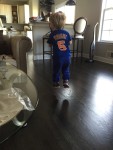
The season has gotten off to a rocky start and increasingly, it is becoming apparent that there are two types of Mets fans – Optimistic and Pessimistic. Here’s the breakdown:
Optimistic: the Mets won in 1969 and 1986. They win in years which have a 6 in them. It’s 2016!
Pessimistic: Tell that to the 1962 – 1968 Mets and the 1976 Mets. Also, someone probably should’ve told that to Carlos Beltran when he didn’t swing the bat.
Optimistic: The ’86 Mets began the year 2-3, and they lost two games to the Phillies.
Pessimistic: The 1992 Mets were also a high profile team people thought were World Series contenders that opened the year 2-3. By the way, the 1986 Phillies were a decent team. The 2016 Phillies are horrendous.
Optimistic: Yoenis Cespedes seemed to get off the snide. He went 2-4 with a homerun and two RBI.
Pessimistic: He’s still batting only .200, and did you see him drop that ball in Kansas City?
Optimistic: The Mets have the best ERA in baseball.
Pessimistic: Matt Harvey has been terrible. It’s only a matter of time before we discover Jacob deGrom needs surgery or he will be out half the year. By the way, the Mets have the best ERA, faced an awful Phillies team, and they’re still under .500.
Optimistic: The bullpen has been off to a terrific start.
Pessimistic: You must’ve missed yesterday’s game when Addison Reed melted down like it was Game 5 of the World Series.
Optimistic: David Wright has looked good to start the year.
Pessimistic: His throws have been terrible, and he’s already had to miss a game.
Optimistic: Neil Walker and Asdrubal Cabrera have looked great up the middle.
Pessimistic: Anything would’ve been an upgrade. By the way, they’re not hitting, and it hasn’t translated to wins. Speaking of wins, the Nationals are 3-1. Coincidentally, they have Daniel Murphy, the guy who carried the Mets in the postseason, is a National. He’s hitting .462/.611/.923.
Optimistic: This team is built to win the World Series, and I’m going to enjoy every single part of the ride.
Pessimistic: I don’t know what team you’re watching.
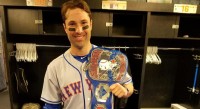
Slowly but surely, Daniel Murphy became my favorite player on the Mets. He was a clutch player at the start. He played the game hard. Yes, he had some gaffes here and there, but they were the result of someone who was going all out all the time. He was never going to admit he couldn’t make a play. As a result, we sometimes got to see him do something spectacular. Other times, you just shook your head.
His being my favorite player was cemented when I met him. When I met him, he came and talked to me about my wife expecting. He signed a few things for my son, and he gave my son a baseball to learn how to play baseball with. Him becoming my son’s favorite player further cemented it.
After the postseason, there should not be one Mets fan who doesn’t love and respect this guy. Without him, the Mets lose in the NLDS.
Despite all that, the Mets didn’t want Murphy back. Instead, they made a bad trade to replace him with Neil Walker. Murphy then went to the Nationals to help them win the NL East. Admittedly, it was difficult watching Walker go 0-4 with a strikeout and an RBI ground out that helped kill a Mets eighth inning rally in an Opening Day loss. It was more difficult seeing that Murphy went 2-3 with two walks, a homerun, and a 10th inning go-ahead RBI double to help the Nationals secure an Opening Day win.
However, that does not mean I’m not rooting for Neil Walker. If you remember, I actually suggested the Mets trade for Walker if they were going to just jettison Murphy. I like Walker as a player. I just think the Mets made a bad decision letting Murphy go, and they made matters worse by making a bad trade. I hope Walker has s huge year. Trust me when I tell you I enjoyed this moment just as much as every other Mets fan, perhaps more:
? ICYMI | Newcomer @NeilWalker18 launched the first #Mets home run of 2016. #LGMhttps://t.co/d8lvAbpVrd
— New York Mets (@Mets) April 5, 2016
I’m undoubtedly rooting for Neil Walker. He’s a good baseball player. He looks to be a great guy too. Just because I love Murphy and hated a trade, it doesn’t mean I’m not rooting for the guy. I am rooting for him. I want to write glowing things about him. I want to implore the Mets to keep him for more than just this year (they won’t). I want to see more big homeruns. I want to see more of the guy that Pirates fans were depressed to see go.
I’ll always be a Mets fan first. I’m going to root for Neil Walker to succeed. I’ll root for whoever’s next, whether that is Dilson Herrera or whoever else or might be. Keep in mind, I rooted for Luis Castillo for FOUR YEARS. I think I can handle rooting for a good player and a good guy like Neil Walker.
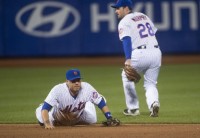
While the Mets are certainly favorites in the NL East, they are not unbeatable. Any team is subject to the injury bug. This team projects to be a high strikeout team. There was the bizarre claim that the position players are too old. However, I did not think that people would cite middle infield defense as a cause. No, seriously.
In an offseason where the Mets jettisoned Daniel Murphy and moved Wilmer Flores to the bench, the narrative has been that the Mets are much improved defensively over last year. It appears not everyone is buying it, so let’s analyze to see if it’s true.
UZR
Generally speaking, Ultimate Zone Ratibg (UZR) measures a fielder’s range. Obviously, the better the number, the better the range. The better the range, the more opportunities to make plays.
In measuring year to year UZR, you may get a sense of how that player performed that season. However, it is too small a sample size to determine the player’s defensive abilities. You need a minimum of three years to do that. As such, to determine if the Mets are better defensively as per UZR, the 2015 UZR, along with the prior two years, should be reviewed.
Here are Murphy’s UZRs for over the past three years:
- 2015 – (1.3)
- 2014 – (5.6)
- 2013 – (4.9)
All told, the combined -11.5 suggests what many already assumed. Murphy is a poor defensive second baseman. In 2016, he’s being replaced by Neil Walker, whose UZR over the past three seasons are as follows:
- 2015 – (6.8)
- 2014 – (6.8)
- 2013 – (1.4)
Walker has a -15 UZR. He’s coming off consecutive -6.8 UZR seasons. At least in terms of UZR, he was worse than Murphy last year, and he’s been worse than Murphy over the part three years. In terms of UZR, the Mets have taken a step back defensively at second.
The Mets sought to upgrade the shortstop position by bringing in Asdrubal Cabrera, who most fans perceived as an upgrade offensively and defensively. Here is Cabrera’s UZR at shortstop over the past three seasons:
- 2015 – (6.0)
- 2014 – (6.6)
- 2013 – (12.8)
Wow. That’s a -25.4. To see if that’s an upgrade, here are Flores’ UZR at shortstop:
- 2015 – (2.5)
- 2014 – 4.0
Now, before we point to Flores’ having a 2.5 UZR over two years, it’s important to note, it’s only two years of data. Furthermore, in each of those two years, Flores was not the everyday shortstop for a full season. Also, your eyes will tell you that he struggled there, especially early in the season. With that said, when thrust into the position in the postseason with no safety net, he played well at shortstop. While the team had defensive miscues in the World Series, Flores was not one of those players.
Also, keep in mind that Cabrera was that poor of a defensive shortstop. Therefore, as far as UZR is concerned, the Mets are actually worse defensively.
DRS
Generally speaking, Defensive Runs Saved (DRS) measures a player’s ability to make plays at their position as opposed to an average player at their position. Like UZR, the higher the number the better. Furthermore, like UZR, DRS is best viewed in three year clips to get a true measure of a player’s ability.
Here is the DRS for Daniel Murphy over the past three years:
- 2015 – (6)
- 2014 – (10)
- 2013 – (13)
Looking over these numbers, Murphy has a cumulative -29 DRS over the past three years. While it can be argued that he’s been improving, it doesn’t change the fact that he’s still a poor defensive second baseman. Conversely, here are Neil Walker’s numbers:
- 2015 – (2)
- 2014 – (2)
- 2013 – 9
In reviewing Walker’s numbers, he may have slipped a little the past two years; however, he’s still a positive 5 in DRS. In reviewing DRS, Walker is a much better defender at second base than Murphy has been.
Neil Walker’s new double play partner, Asrubal Cabrera, has not had DRS numbers as strong as Walker:
- 2015 – (7)
- 2014 – (7)
- 2013 – (16)
Again, Cabrera has ugly numbers. Over the past three years, he sits at a -30 DRS. For someone that is supposed to be an upgrade, these are not promising numbers. However, in order to determine if he’s actually an improvement, we need to look at Flores’ numbers:
- 2015: (10)
- 2014: (3)
Again, the caution with Flores is that these stats are a small sample size. He still hasn’t played a full season at the position. With that said, if you wanted a stat to confirm the your eye test, this stat is the one. However, before casting dispersions on Flores, keep in mind the Mets are replacing him with a bad shortstop with limited range.
Conclusion
Using UZR and DRS, there is a reasonable debate to be had as to whether Murphy or Walker is better at second base. However, when framing those arguments, it should be noted Walker has been in decline the past few years. So yes, Walker MIGHT be better, but it’s also true he’s getting worse at the position.
As for shortstop, the only thing we truly know is that Cabrera is bad defensively. He’s 30 years old and not likely to get any better. He’s replacing a 24 year old that seemingly grew into the position. Flores played very well defensively in the postseason.
Overall, while Mets fans may believe the team is better off defensively without Murphy and Flores up the middle, the stats don’t bear that out. Rather, the Mets are more likely to have the same deficiencies they had last year.
If you are going to argue the current Mets double play combination is better, it is not because of their defense.
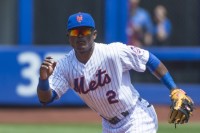
After the Mets make a decision at catcher, the team appears like they will have between $82 – $96 million to build a roster and re-sign their pitching.
Looking at the roster, the Mets will need to obtain starters at the following positions: 1B, 2B, SS, and RF. David Wright is scheduled to make $15 million, so whether or not you believe he will be able to stay at the position, he will remain with the team in some capacity. Michael Conforto should still be with the team as the leftfielder. Finally, unless the Mets can move him, Juan Lagares and his $9 million salary will be the team’s centerfielder. The Mets organization is fairly well stocked with position players right now, and they might be able to fill out the roster with cheap, cost-controlled talent.
First Base
Somewhat controversely, Keith Law named Dominic Smith the 29th best prospect in all of baseball. He’s the first baseman of the future.
Accordingly to the scouting reports, Smith is a good defensive first baseman that should be able to hit. The debate really is whether he will hit for power. Whether or not he hits for power, people see him as being able to field the position and be a good major league hitter.
With Lucas Duda being a free agent in 2018, the Mets will need Smith to be ready. If he’s not ready, the Mets will need a stopgap. In either event, by the time the Mets pitchers start to become free agents, Smith should be the first baseman earning around $500,000.
Second Base
We have to assume that one of these years Dilson Herrera is going to transition from second baseman of the future to the Mets second baseman. With Neil Walker only having one year until free agency, it appears that time will be 2017.
Right now, Herrera has less than one year’s service time. For all the supposed newfound depth, it’ll probably be Matt Reynolds getting called up to the Mets. That will preserve his service time. It means that in 2019, Herrera should be the second baseman, and he will have accrued two full years service time. Unless he gets enough playing time, it appears like he will avoid Super Two status meaning he will be in the same $500 – $600 thousand range as Smith.
Shortstop
As far as organizational depth, the Mets seemingly have an embarassment of riches with two high end shortstop prospects with Gavin Cecchini and Amed Rosario. They also have the aforementioned Reynolds.
Given Asdrubal Cabrera‘s contract, Cecchini and Rosario are going to have time to develop on the minors. At a minimum, Cabrera is signed to be the Mets shortstop through the 2017 season. If he produces well, or the prospects need another year, Cabrera has an option that could keep him with the Mets through the 2018 season.
As such, neither Cecchini or Rosario will be arbitration eligible at the time the Mets pitchers start to reach free agency. Accordingly, the Mets will only have to spend around $500 thousand when the pitchers begin to become free agents.
Left Field
It seems Michael Conforto is the leftfielder of the past (2015), present, and future. He very well should be too. Even if Conforto doesn’t improve upon his 162 game averages he achieved as a 22 year old, who never played above AA, you’re getting a good defensive outfielder who will hit .270/.335/.506 with 26 homers and 75 RBI.
Fortunately, Conforto will not have accrued enough service time to achieve Super Two status. Unfortunately, Conforto will most likely become arbitration eligible the same time that the Mets pitchers are reaching free agency.
Looking over the past few years, there isn’t really a good comparable to Conforto. It seems that when teams have good young corner outfielders, they lock them up. With that in mind, although an admittedly imperfect comparison, J.D. Martinez is instructive.
In 2014, Martinez was 26 years old, and he hit .325/.358/.553 with 23 homers and 76 RBI in 123 games. He became arbitration eligible after this season, and he agreed to $3 million. In 2015, he had another good year hitting .282/.344/.535 with 38 homeruns and 102 RBI. He and the Tigers avoided an arbitration hearing. Martinez’s contract extension bought out the remainder of his arbitration years he’s due to make $6.75 million in 2016 and $11.75 million in 2017.
While we may or may not agree on whether Martinez is a good comparable, it would be fair to say Conforto is at least capable of hitting .272/.344/.535 by his age 25 season, if not sooner. If that’s the case, it would be fair to suggest Conforto could earn anywhere from $3 – $6 million in his first year of eligibility.
Right Field
Curtis Granderson‘s contract will expire after the 2017 season. Since he will be 37 heading into the 2018 season, it’s hard to imagine he will be re-signed to be the everyday right fielder.
Now, Wuilmer Becerra projects to be an everyday player. Scouts believe he has the bat to play the corner outfield spot. The issue as far as the Mets are concerned is how quickly the 21 year old minor leaguer will need before fulfilling that promise. Last year, Becerra played his first year in full season A ball. That’s a long trek to the majors by 2019.
So unless Brandon Nimmo can handle the corner outfield offensively, which unfortunately seems unlikely, the Mets will have to look outside the organization to fill that void.
If Becerra is still a well regarded prospect, the Mets are likely to bring in a player on a one to two year deal. In retrospect, depending on how he finishes out his contract, Granderson could be coaxed back on a one-year deal ata much lower contract price.
As a placeholder, let’s presume the cost of a right fielder would cost about $15 million. That’s what Granderson is slated to earn the last year of his contract.
Cost of the Projected 2019 Starting Lineup
If everything breaks right for the Mets, they will have a group of young, cost-controlled position players at the time their starting pitchers hit the free agent market. If this pans out, the Mets everyday position players would cost about $46.5 million.
That’s roughly what the Mets are paying their current starting infield. In total, the 2016 Mets starting lineup is due to be paid roughly $90 million. Essentially, the Mets will be spending half the amount of money on their starting lineup in 2019 than they will this season.
Overall, this leaves the Mets between $35.5 – $49.5 million to build a bench, a bullpen, and to pay their starting rotation if the payroll remains stagnant at the $140 million range.

While everyone is trying to decipher the outfield configuration after the Yoenis Cespedes signing, there is the issue of how the signing puts added importance on Wilmer Flores‘ ability to be a backup infielder.
Third Base
Make no mistake. The Mets need Flores to be able to handle the role and handle it well. For starters, we do not know David Wright‘s ability to withstand a full 162 game schedule. Last year, Wright had difficulty playing three days in a row. It impacted his offense and defense. With a full offseason to continue the extra work needed due to his spinal stenosis, that could change for Wright. It also may be a new reality.
Flores has to be ready, willing, and able to play third at a monent’s notice. In his major league career, Flores has only played 209 innings at third base. During that limited time, he did show the ability to handle the position. The problem is he has to work on his third base defense while addressing his second base defense.
Second Base
When the Mets acquired Neil Walker to replace Daniel Murphy, the Mets obtained a switch-hitting second baseman who has hit .272/.338/.427 over the course of his career. That’s with him coming off the worst year of his career last year when he hit .269/.328/.427 with 16 homers and 71 RBI. One of Walker’s issues last year was left-handed pitching. Walker hit a dreadful .237/.284/.290 in 62 games against lefties. For his career, Walker has hit an underwhelming .260/.317/.338 against lefties in his career. Effectively, Walker is a platoon player.
Ideally, that platoon parter would be Flores. However, Flores has to be able to hit lefties himself. Last year, Flores did that with aplomb. In 57 games, Flores hit .310/.355/.600 with 7 of his 16 homers against lefties last year. However, for his career, Flores has only hit .230/.288/.403 against lefties in his brief major league career. Overall, for the Walker trade to work Flores needs to be the 2015 version of himself against lefties as opposed to what he’s done against them in his entire career.
First Base
First base is where it starts to get dicey for Flores. With the Cespedes signing, Lucas Duda became the only player on the roster with any major league experience at first base. This forces Flores to learn a new position in addition to keeping prepared for his other backup roles.
How much Flores is needed will depend on Duda. Last year, Duda hit a respectable .285/.333/.545 with seven homers and 21 RBI in 82 games. However, much of that was fueled by an extraordinarily high BABIP of .385. For his career, Duda has hit .229/.301/.369 with a .321 BABIP. In short, Duda is due for a regression against lefties. It will be Flores’ job to cushion the fall back to earth while hoping his numbers against lefties doesn’t regress either.
Shortstop
The Mets signed Asdrubal Cabrera to be the new everyday shortstop. A role that used to belong to Flores. Cabrera’s backup to open the season should be Ruben Tejada, who actually wrestled the shortstop job away from Flores last year.
Here’s the issue. The one spot Flores isn’t backing up is the one spot he’s most needed. Last year, Cabrera had a -6.0 UZR and a -7 DRS at shortstop. For his career, he has a -55.5 UZR and a -29 DRS at short. Tejada had a -5.6 UZR and a -15 DRS at short last year. For his career, he has a -1.5 UZR and a -20 DRS there. Flores had a -2.5 UZR and a -10 DRS at short last year with a 1.5 UZR and a -13 DRS for his career.
So defensively, Flores is the best shortstop option. However, the Mets are going with Cabrera in the hopes that his .328/.372/.544 second half will carry forward because otherwise the Mets signed a shortstop who has hit .249/.307/.405 in the three years since his last All Star appearance. Ironically, the position Flores is best suited to on this team is not a position he is tops on the depth chart going into next season.
Pinch Hitter
Since this is the National League, Flores will need to be ready to pinch hit for the pitcher or for a left handed when a LOOGY enters the game. In his career, Flores has only had 13 plate appearances where he hit .250/.308/.333. These are around his career numbers of .253/.287/.386. Accordingly, Flores can reasonably be expected to replicate his career batting line as a pinch hitter next year. Whether that’s good or not is a whole other matter.
Conclusion
Surprisingly, much of what the Mets want to do lies on Flores’ shoulders. He had to platoon at second. He had to hit against tough left-handles while playing first. He has to be available at a moment’s notice to play third. He’s available to play each and every one of these roles because the Mets are placing their top shortstop option, Flores, on the bench.
Flores is still only 24 years old. He works hard, and he will do everything he can do to improve and help the team. He’s going to need to be proficient in three to four infield positions because the Mets really need his help.
Editor’s Note: this article first appeared on metsmerized.com
